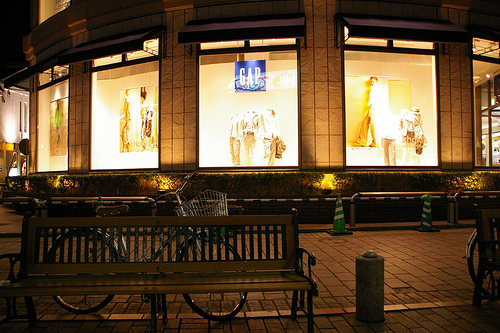<p>We live in a cash-driven consumer society where hardly a day goes by without us buying something. Shopping is more than something that we do to pick up necessary food and clothes &#8211; for many people it is a hobby, an art or even a form of therapy. In our consumer world, choice is king. With all this money flowing out of our pockets and into the retail sector, it’s no wonder that brands are using all sorts of tactics to draw our attention to their products while stores are trying to lure us into their doors.</p>
<p>Marketing gurus are being paid top dollar to come up with techniques to increase consumer loyalty to specific brands and with new advances in technology, the science and psychology of consumer preference is becoming more sophisticated by the day.</p>
<p style="text-align: center;"><img class="aligncenter" alt="" src="http://myblogguest.com/forum/uploads/articles/2013/10/419065395_84bc8f6c19.jpg" width="510" height="343" /></p>
<h2><strong>Digger deeper with technology</strong></h2>
<p>Neuroscience – which also deals with the psychology of how the brain functions – has been applied to studies which deal with the way that consumers’ brains react during their shopping experience. EEG readings of brain activity can be done inside real or mock stores to see which setups or brands elicit reaction in specific parts of the brain. Combined with eye-tracking equipment technology, the readings can tell exactly what chemical responses are created in the brain according to what product the subject is looking at.</p>
<p>Another exciting technology that is being used in retail psychology research is Video Realistic Technology (VRT). Instead of a real store, the subject will be walking through a 3D simulation of a store where they can still pick up the virtual products, read labels or interact with other 3D shoppers, all while brainwave readings are being taken. The great advantage of this kind of technology is that product placement or store environments can be changed with the click of a button to give researchers infinitely more freedom regarding product, signage or display placement.</p>
<h2><strong>The importance of product placement</strong></h2>
<p>When retailers are deciding where to place the products on their shelves they draw a lot on the concept of visual merchandising. Wikipedia defines visual merchandising as the profession or activity of developing the best floor plans and displays with the purpose of maximizing sales. This includes an array of factors, including window- or shelf displays, packaging, colour, lighting, signage, staff uniforms, packaging shape and texture and how the consumer views the store in general.</p>
<p>From a brand perspective, where your product is placed on the shelves also makes a huge difference. Studies have found that we scan products horizontally at eye level, not up and down. Products that are sold for the highest margin are usually placed at eye level to ensure maximum profits. Further consumer psychology is used when designing aisles, as it’s been proven that we are more likely to buy when we move with products in clear line of sight. We also are more likely to pick up products at the end of aisles, especially if they are on special. (http://mentallyfine.com/the-psychology-of-retail-display/)</p>
<h2><strong>The effect of colour and texture</strong></h2>
<p>Products with their colourful packaging mimics an exhibition on display and a well-planned system is followed when designers decide what shapes and colours to use for their brand. Texture also plays an important role, as research has shown that our brains prefer natural textures to artificial ones. Luckily for the visual marketers, our brains respond the same to synthetic materials that look like the real thing.</p>
<p>For brands, the type of colour used in the logo will also elicit a certain emotional response from their customers and it is important to know who exactly your target market is. As an example, fast food outlets prefer using the colours red, yellow and white because of the unspoken associations we make with it. Yellow is a positive colour, but makes us anxious so in the fast food industry it ensures that people move through fast. The red symbolizes excitement and energy and also stimulates appetite, while we associate white with hygiene – something important in the fast food industry.</p>
<h2><strong>Subtle sleight of hand</strong></h2>
<p>The hidden ways that the retail industry uses to nudge our preferences in a certain direction are incredible. By subtle things such as music choice, they encourage us to spend more money than we initially planned to. By selling matching products together, for example a salsa with the chips, we often times buy products we don’t need. By selling something for 9.99 instead of 10.00, we softly get fooled into thinking that we are getting a bargain when we are still paying a big margin on the product. Every product placement, every colour, every arrangement is intentional and it is all to make us spend more money.</p>
<p>In all fairness – consumerism it is a whole psychology and science and it is continually being researched to refine the art of separating us from our hard-earned money. Knowing this could make us feel like victims of sly psychological tricks, but perhaps the real question is why we are allowing ourselves to be manipulated in the first place.</p>
<h5>Featured images:</h5>
<p><span class="license">License: Creative Commons</span></p>
<p><span class="source">image source</span></p>
<p><em>Marilu Snyders considers herself a smart shopper who isn&#8217;t fooled by blatant marketing tactics. But she still has the utmost respect for the principles of<em> consumer psychology, so long as as they are used for good by companies such as </em></em><em>Trigasystems.com and not for evil</em><em>. </em></p>

How We Are Influenced By Retail Displays
